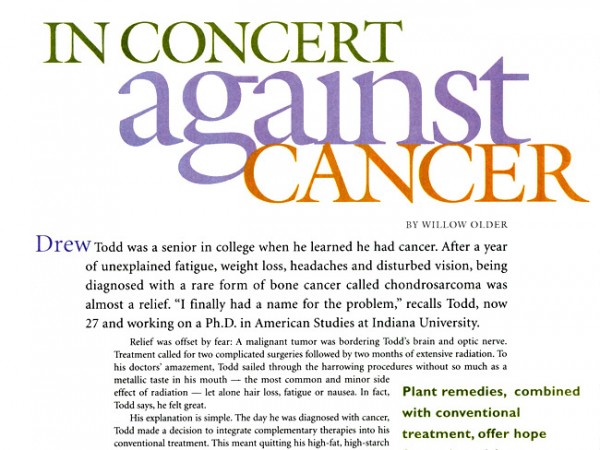
Delicious Magazine (Writing Sample)
In Concert Against Cancer
Drew Todd was a senior in college when he learned he had cancer. After a year of unexplained fatigue, weight loss, headaches and disturbed vision, being diagnosed with a rare form of bone cancer called chondrosarcoma was almost a relief. “I finally had a name for the problem,” recalls Todd, now 27 and working on a Ph.D. in American Studies at Indiana University.
Relief was offset by fear: A malignant tumor was bordering Todd’s brain and optic nerve. Treatment called for two complicated surgeries followed by two months of extensive radiation. To his doctors’ amazement, Todd sailed through the harrowing procedures without so much as a metallic taste in his mouth – the most common and minor side effect of radiation – let alone hair loss, fatigue or nausea. In fact, Todd says, he felt great.
His explanation is simple. The day he was diagnosed with cancer, Todd made a decision to integrate complementary therapies into his conventional treatment. This meant quitting his high-fat, high-starch diet and adopting a strict macrobiotic nutrition plan, incorporating foods like shiitake and maitake mushrooms and root vegetables such as burdock. At the same time, he had regular acupuncture treatments and practiced yoga, visualization and mediation. Throughout his treatment, Todd felt strong, energetic and optimistic. His doctors call his recovery a miracle. But Todd has a different theory. “There’s no doubt that surgery and radiation killed the tumor,” he says. “But where Western medicine stopped, Eastern medicine took over. I’m convinced that traditional and alternative therapies should work together to create a more holistic recovery process.”
The Best of Both Worlds
Todd’s experience supports the positive impact of a comprehensive approach to treating cancer. When traditional pharmacology meets alternative “phytotherapy” – the science of using herbs and other plants medicinally – two strikingly different philosophies join forces. Allopathic (conventional) medicine uses two primary weapons against cancer: chemotherapy and radiation. To describe the treatments as weapons is particularly apt since conventional doctors commonly view cancer as an enemy invader that must be destroyed at any cost. “Chemotherapy and radiation are toxins that kill cancer cells. Unfortunately, they kill healthy cells, too,” say Glenn Rothfeld, M.D., L.Ac., of Cambridge WholeHealth Center in Arlington, Mass. That’s why hair loss, fatigue and nausea are considered an inevitable price of cancer treatment.
For herbalists, destroying cancer cells is only a partial goal. Equally important is strengthening an immune system that has been twice compromised: first by the illness and then by aggressive treatment. It seems logical that a healthy immune system can help patients endure grueling cancer treatments with a better attitude, more energy and few side effects than expected.
“Herbs help cleanse the body and allow the immune system to function,” says Jing Liu, L.Ac., founder of the Acupuncture and Herbs clinic in Lexington, Mass. “Many patients feel better within two weeks of using herbal therapies.”
Michael Lerner, Ph.D., president and founder of Commonweal, a health and environmental research institute in Bolinas, Calif., believes herbal therapies are “one of the many areas of complementary medicine that is moving forward most rapidly toward scientific assessment.” He cautions, however, that while some herbs are effective against some forms of cancer in laboratory tests, and other herbs – notably traditional Chinese medicine preparations – show promise in treating human beings, “there is no evidence of a curative treatment for cancer among herbal therapies.” Moreover, warns Dan Labriola, N.D., a naturopathic physician and director of the Northwest Natural Health Specialty Care Clinic in Seattle, “if used inappropriately, natural remedies can interfere with the action of conventional treatment.”
The appropriate supervised use of herbs, however, has proven very effective. Says Liu, “Herbs help the body respond better to treatment. Integrated therapies are producing better results than ever before.”
Health Merits of Herbs
For more than two millennia, traditional Chinese medicine (TCM) has relied on plant and herbs to cure minor and severe ailments. TCM is based on the belief in qi (pronounced “chee”), our life force, or the vital energy that keeps our blood, nerves and organs in balance. Rothfeld explains that illness indicates qui that is out of balance: Equilibrium must be restored for the body to heal itself.
Cancer can wreak havoc with one’s qi. According to TCM, tumors indicate a blockage or obstruction of inner vitality. Removing or softening this blockage is crucial, but the immune system must be simultaneously strengthened. A carefully selected combination of herbs, says Liu, can purify and boost the immune system curing chemotherapy and radiation. Herbs can also minimize the side effects of harsh treatments while helping fight the cancer itself.
Fu Zhen is a blend of Chinese herbs often used as an adjunctive cancer therapy. The mixture of ginseng (Panax ginseng), ligustrum (Ligustrum lucidum), astragalus (Astragalus membranaceus), atractylodes (Atractylodis rhizome) and ganoderma (Ganoderma lucidum) stimulates the body’s natural anticancer defenses (Cancer Biotherapy, 1994, vol. 9, no. 2).
Astragalus increases the activity of natural killer (NK) cells, which recognize and destroy cancer cells at first sight and improve the efficacy of interferon, a protective protein produced when a virus is lurking (Cancer Biotherapy, 1994, vol. 9, no. 2).
Chinese herbs are traditionally taken in the form of tea, but since they aren’t known for great taste, tinctures or powders are often more palatable.
Leafy Green Protection
The annoyingly prickly plant that catches your socks, shirt and shoelaces when you’re hiking may be a valuable friend if you have cancer. A member of the thistle family, burdock (Arctium lappa) contains arctigenin a chemical armed with anti-mutation properties. Mutated cells can produce cancer, and laboratory studies show that burdock helps minimize mutation (Mutation Research, vol. 129, no. 1).
Like other leafy greens, burdock is also an effective antioxidant, protecting healthy cells from damage by free radicals, unstable molecules that promote tumor growth (Anticancer Research, 1998, vol. 18, no. 2A). But, because some chemotherapy regimens blast tumors with oxidants, allopathic doctors worry that antioxidants may actually undermine treatment.
On the other hand, Rothfeld points out, the antioxidants and nutrients in leafy greens give patients a dose of natural anticancer compounds. To avoid putting chemotherapy and burdock at cross purposes, he recommends limiting antioxidant intake during chemotherapy and boosting it once treatment ends.
An Anticancer Clover
When James Duke, Ph.D., an economic botanist and former U.S. Department of Agriculture researcher, tosses red clover sprouts into salads, he isn’t seeking simply flavor or crunch. Red clover (Trifolium pratense) contains genistein, an anticancer compound that prevents new blood vessels from forming within a tumor. (Genistein can also be found in soy, black beans and peanuts.) Since tumors rely on new blood vessels to grow, genistein effectively starves the cancer.
Red clover is one of the worlds’ oldest and most common natural cancer remedies. In fact, one study found that 33 cultures use the herb against the disease. However it may create problems for certain cancer patients. For example, says Labriola, women being treated for breast cancer with the drug tamoxifen show avoid red clover because tamoxifen prevents estrogen from reaching a tumor, and phytoestrogenic compounds in red clover could undermine that action. In this case, it’s possible red clover could feed, not starve, an estrogen-dependent breast tumor, Labriola warns.
The scientific study of red clover is still new. Although its anticancer compounds make it an effective cancer-fighting food for some people, only further research will clarify red clover’s future cancer treatment role (Cancer Research, vol. 48, no. 22).
A Master Mushroom
Asian mushrooms are perhaps the single best way to take your medicine and have dinner, too. Often touted as a perfect food, these mushrooms are low in fat and high in amino acids, vitamins and nutrients. But not all Asian mushrooms are created equal. Studies conducted in Japan reveal maitake as the shining star.
Meaning “dancing mushroom” in Japanese, maitake (Grifola frondosa) may be cancer’s greatest edible enemy. One study shows that maitake’s unique “D-fraction” extract makes NK cells powerful against tumors, reducing tumor growth by 80 percent. Maitake also boosts levels of interleukin-1, an immune system protein that fights cancer and other viruses. In addition, animal studies show the mushroom lowers lipid levels and give the immune system a natural boost (Biological and Pharmaceutical Bulletin, July 1997).
While most mushroom extracts need to be injected for maximum potency, maitakes are equally effective when taken orally. Whether ingested as a dietary supplement or included as part of your evening meal, maitakes appear to be one of nature’s most important medicinal gifts.
A Case for Integration
Mighty as these herbal healers may be, they shouldn’t be consumed excessively or casually. “Herbs may be all natural,” says Ralph Moss, Ph.D., scientific advisor for Columbia University’s Rosenthal Center and the University of Texas, “but as medicines, they can be extremely powerful.”
He emphasizes that an oncologist should be told about any nontraditional treatments you are taking. “Doctors can be misled by unexpected responses,” explains Moss. “If herbs are making chemotherapy more effective, an uniformed doctor might decide to intensify the treatment.”
Moss adds that interactions between herbs and pharmaceuticals can sometimes be toxic. To avoid complications, all cancer therapies – whether conventional or alternative – should be supervised by a health care practitioner.
Of course, the best cancer treatment is preventative. A diet rich in grains, fresh fruits and vegetables, and low in fats and processed foods is a healthy start. Avoiding cigarettes and alcohol, and exercising regularly also helps.
Todd believes something else is vital for fighting or avoiding cancer. “Seeking out and practicing alternative therapies has made me an active participant in my own recovery. Rather than fall into the passive-patient mode,” Todd continues, “I made crucial decisions about my lifestyle. Nothing could be more empowering.”
